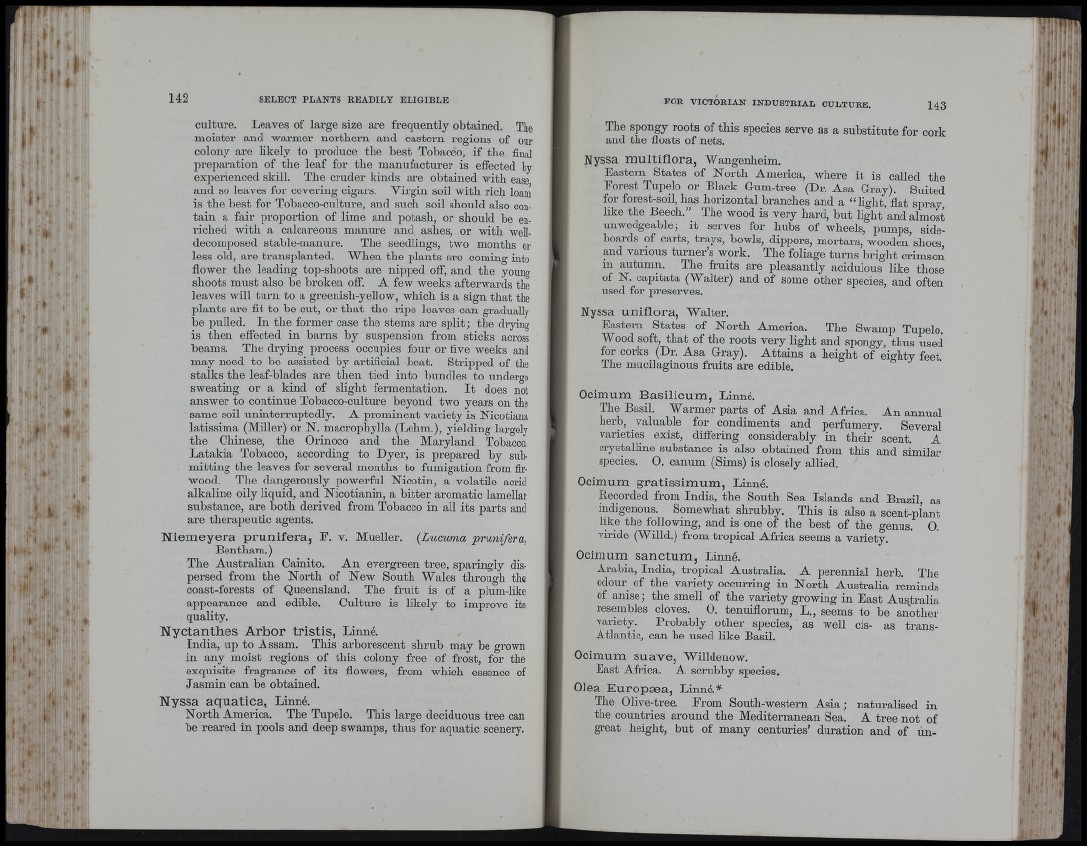
(
’ (i h
)> u
142 SELECT PLANTS READILY ELIGIBLE
culture. Leaves of large size are frequently obtained. The
moister and warmer nortliern and eastern regions of our
colony are likely to produce the best Tobacco, if the final
prepai-ation of the leaf for the manufacturer is efiected by
exjierienced skill. The cruder kinds are obtained with ease
and so leaves for covering cigars. Virgin soil with rich loam
is the best for Tobacco-cnlture, and such soil should also contain
a fair proportion of lime and potash, or should he enriched
with a calcareous manure and ashes, or with well-
decomposed stable-manure. The seedlings, two months or
less old, are transplanted. When the plants are coming mto
fiower the leading top-shoots are nipped oif, and the youn»
shoots must also be broken off. A few weeks afterwards the
leaves will turn to a greenisb-yellow, which is a sign that the
plants are fit to be cut, or th a t the ripe leaves can gradually
be pulled. In the former case the stems are split; the drying
is then efiected in barns by suspension from sticks across
beams. The drying process occupies four or five weeks and
may need to be assisted by artificial heat. Stripped of the
stalks the leaf-blades are then tied into bundles to undergo
sweating or a kind of slight fermentation. I t does not
answer to continue Tobacco-cnlture beyond two years on the
same soil uninterruptedly. A prominent variety is Nicotiana
latissima (Miller) or N. macrophylla (Lelim.), yielding largely
the Chinese, the Orinoco and the Maryland Tobacco.
Latakia Tobacco, according to Dyer, is prepared by submitting
the leaves for several months to fumigation from fir-
wood. Tbe dangerously powerful Nicotin, a volatile acrid
alkaline oily liquid, and Nicotianin, a bitter aromatic lamellar
substance, are both derived from Tobacco in all its parts and
are therapeutic agents.
Niemeyera prunifera, F. v. Mueller. (Lucuma prunifera,
Bentham.)
The Australian Cainito. An evergreen tree, sparingly dispersed
from tbe North of New South Wales through the
coast-forests of Queensland. The fruit is of a plum-like
appearance and edible. Culture is likely to improve its
quality.
Nyctanthes Arbor tristis, Linné.
India, up to Assam. This arborescent shrub may be grown
in any moist regions of tbis colony free of frost, for the
exquisite fragrance of its flowers, from which essence of
Jasmin can be obtained.
Nyssa aquatica, Linné.
North America. The Tupelo. This large deciduous tree can
be reared in pools and deep swamps, thus for aquatic scenery.
FOR VICTORIAN INDUSTRIAL CULTURE. 143
The spongy roots of this species serve as a substitute for cork
and the floats of nets.
Nyssa multiflora, Wangenheim.
Eastern States of North America, where it is called the
Forest Tupelo or Black Gum-tree (Dr. Asa Gray). Suited
for forest-soil, has horizontal branches and a “ light, flat spray
like the Beech. The wood is very hard, but light and almost
unwedgeable, it serves for bubs of wheels, pumps, sideboards
of carts, trays, bowls, dippers, mortars, wooden’shoes
mid various turner’s work. The foliage turns bright crimson
in autumn. The fruits are pleasantly acidulous like those
of N. capitata (Walter) and of some other species, and often
used for preserves.
Nyssa uniflora, Walter.
Eastern States of North America. The Swamp Tupelo.
Wood soft, that of the roots very light and spongy, thus used
for corks (Dr. Asa Gray). Attains a height of eighty feet.
The mucilaginous fruits are edible.
Ocimum Basilicum, Linné.
The Basil. Warmer parts of Asia and Africa. An annual
herb, valuable for condiments and perfumery. Several
varieties exist, difiering considerably in their scent. A
crystalline substance is also obtained from this and Rimilnv
species. O. canum (Sims) is closely allied.
Ocimum gratissimum, Linné.
Recorded from India, the South Sea Islands and Brazil, as
indigenous. Somewhat shrubby. This is also a scent-plant
like the following, and is one of the best of the genus. 0 .
viride (Willd.) from tropical Africa seems a variety.
Ocimum sanctum, Linné.
Arabia, India, tropical Australia. A perennial herb. The
odour of the variety occurring in North Australia reminds
of anise; the smell of the variety growing in East Aus,tralia
resembles cloves. O. tenuiflorum, L., seems to be another
variety. Probably other species, as well cis- as trans-
Atlantic, can be used like Basil.
Ocimum suave, Willdenow.
East Africa. A scrubby species.
Olea Europæa, Linné.*
The Olive-tree. Erom South-western Asia; naturalised in
the countries around the Mediterranean Sea. A tree not of
great height, but of many centuries’ duration and of un-
{ ■ 1I,
; f. i" ^ I
■ii', ■
I . I
I *
i ' ti
4 : 'V "
■A.,!
■ ■!
H ' il